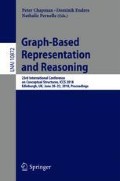Abstract
Standard approaches for inference in probabilistic formalisms with first-order constructs include lifted variable elimination (LVE) for single queries, boiling down to computing marginal distributions. To handle multiple queries efficiently, the lifted junction tree algorithm (LJT) uses a first-order cluster representation of a knowledge base and LVE in its computations. Another type of query asks for a most probable explanation (MPE) for given events. The purpose of this paper is twofold: (i) We formalise how to compute an MPE in a lifted way with LVE and LJT. (ii) We present a case study in the area of IT security for risk analysis. A lifted computation of MPEs exploits symmetries, while providing a correct and exact result equivalent to one computed on ground level.
Access this chapter
Tax calculation will be finalised at checkout
Purchases are for personal use only
References
Braun, T., Möller, R.: Lifted junction tree algorithm. In: Friedrich, G., Helmert, M., Wotawa, F. (eds.) KI 2016. LNCS (LNAI), vol. 9904, pp. 30–42. Springer, Cham (2016). https://doi.org/10.1007/978-3-319-46073-4_3
Ceylan, İ.İ., Borgwardt, S., Lukasiewicz, T.: Most probable explanations for probabilistic database queries. In: Proceedings of the 26th International Joint Conference on Artificial Intelligence (2017)
Chen, H., Erol, Y., Shen, E., Russell, S.: Probabilistic model-based approach for heart beat detection. Physiol. Measur. 37(9), 1404 (2016)
Dawid, A.P.: Applications of a general propagation algorithm for probabilistic expert systems. Stat. Comput. 2(1), 25–36 (1992)
Dechter, R.: Bucket elimination: a unifying framework for probabilistic inference. In: Learning and Inference in Graphical Models, pp. 75–104. MIT Press (1999)
Gribkoff, E., van den Broeck, G., Suciu, D.: The most probable database problem. In: Proceedings of the 1st International Workshop on Big Uncertain Data (2014)
Lauritzen, S.L., Spiegelhalter, D.J.: Local computations with probabilities on graphical structures and their application to expert systems. J. R. Stat. Soc. Ser. B: Methodol. 50, 157–224 (1988)
Milch, B., Zettelmoyer, L.S., Kersting, K., Haimes, M., Kaelbling, L.P.: Lifted probabilistic inference with counting formulas. In: Proceedings of the 23rd Conference on Artificial Intelligence, AAAI 2008, pp. 1062–1068 (2008)
Muñoz-González, L., Sgandurra, D., Barrère, M., Lupu, E.C.: Exact inference techniques for the analysis of Bayesian attack graphs. IEEE Trans. Dependable Secure Comput. PP(99), 1–14 (2017)
Nilsson, D.: An efficient algorithm for finding the M most probable configurations in probabilistic expert systems. Stat. Comput. 8(2), 159–173 (1998)
Pearl, J.: Probabilistic Reasoning in Intelligent Systems: Networks of Plausible Inference. Morgan Kaufmann, Burlington (1988)
Poole, D.: First-order probabilistic inference. In: Proceedings of the 18th International Joint Conference on Artificial Intelligence, IJCAI 2003 (2003)
de Salvo Braz, R.: Lifted first-order probabilistic inference. Ph.D. thesis, University of Illinois at Urbana Champaign (2007)
de Salvo Braz, R., Amir, E., Roth, D.: MPE and partial inversion in lifted probabilistic variable elimination. In: Proceedings of the 21st Conference on Artificial Intelligence, AAAI 2006 (2006)
Schröder, M., Lüdtke, S., Bader, S., Krüger, F., Kirste, T.: LiMa: sequential lifted marginal filtering on multiset state descriptions. In: Kern-Isberner, G., Fürnkranz, J., Thimm, M. (eds.) KI 2017. LNCS (LNAI), vol. 10505, pp. 222–235. Springer, Cham (2017). https://doi.org/10.1007/978-3-319-67190-1_17
Shenoy, P.P., Shafer, G.R.: Axioms for probability and belief-function propagation. Uncertain. Artif. Intell. 4(9), 169–198 (1990)
Shterionov, D., Renkens, J., Vlasselaer, J., Kimmig, A., Meert, W., Janssens, G.: The most probable explanation for probabilistic logic programs with annotated disjunctions. In: Davis, J., Ramon, J. (eds.) ILP 2014. LNCS (LNAI), vol. 9046, pp. 139–153. Springer, Cham (2015). https://doi.org/10.1007/978-3-319-23708-4_10
Taghipour, N., Davis, J., Blockeel, H.: First-order decomposition trees. In: Advances in Neural Information Processing Systems 26, pp. 1052–1060. Curran Associates, Inc. (2013)
Taghipour, N., Fierens, D., Davis, J., Blockeel, H.: Lifted variable elimination: decoupling the operators from the constraint language. J. Artif. Intell. Res. 47(1), 393–439 (2013)
Zhang, N.L., Poole, D.: A simple approach to Bayesian network computations. In: Proceedings of the 10th Canadian Conference on Artificial Intelligence, pp. 171–178 (1994)
Author information
Authors and Affiliations
Corresponding author
Editor information
Editors and Affiliations
Rights and permissions
Copyright information
© 2018 Springer International Publishing AG, part of Springer Nature
About this paper
Cite this paper
Braun, T., Möller, R. (2018). Lifted Most Probable Explanation. In: Chapman, P., Endres, D., Pernelle, N. (eds) Graph-Based Representation and Reasoning. ICCS 2018. Lecture Notes in Computer Science(), vol 10872. Springer, Cham. https://doi.org/10.1007/978-3-319-91379-7_4
Download citation
DOI: https://doi.org/10.1007/978-3-319-91379-7_4
Published:
Publisher Name: Springer, Cham
Print ISBN: 978-3-319-91378-0
Online ISBN: 978-3-319-91379-7
eBook Packages: Computer ScienceComputer Science (R0)

